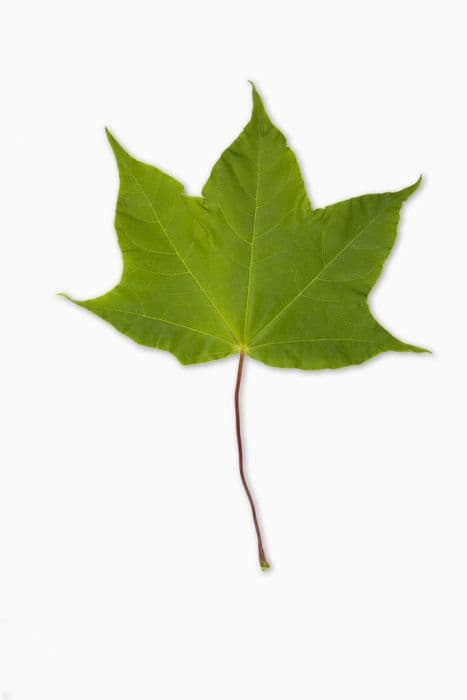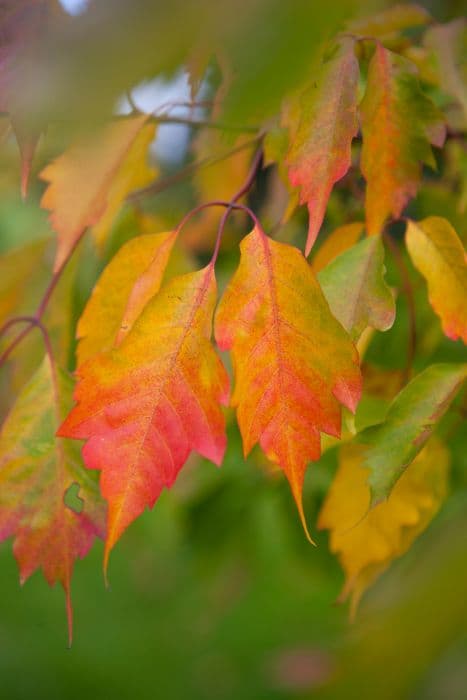Japanese maple Acer palmatum 'Hana-matoi' (PBR) (v)

ABOUT
Acer palmatum 'Hana-matoi', often known as Japanese maple, is a striking ornamental plant recognized for its beautifully variegated foliage. The leaves of this cultivar have a unique appearance, characterized by their deeply cut, feathery lobes which often resemble the shape of a hand with outstretched fingers. The variegation in the leaves is remarkable, displaying a blend of colors that can include shades of green, pink, white, and sometimes creamy-yellow hues. During the spring, the new growth can emerge with a strong pink tint that gradually transitions to green with pink and white edges as it matures. Come fall, the leaves often transform into a stunning display of fiery colors, with vivid reds, oranges, and yellows taking center stage, creating a dramatic contrast against the landscape. The bark of the Japanese maple is typically smooth and gray, further accentuating the vibrancy of the leaves. This plant, with its intricate leaf patterns and changing color palette, provides year-round visual interest and is often chosen for its aesthetic appeal in garden designs.
About this plant
 Names
NamesFamily
Sapindaceae.
Synonyms
Japanese Maple, Hana-matoi Japanese Maple.
Common names
Acer palmatum 'Hana-matoi' (PBR) (v)
 Toxicity
ToxicityTo humans
Japanese Maple is not generally recognized as toxic to humans. There are no well-documented cases of poisoning from ingesting the plant, and it is not known to cause adverse effects when handled or consumed in small quantities.
To pets
Japanese Maple is generally considered non-toxic to pets. There is no concrete evidence that ingestion of this plant by pets such as dogs and cats leads to poisoning or serious health issues. However, consumption of any plant material can potentially cause mild stomach upset in some animals.
 Characteristics
CharacteristicsLife cycle
Perennials
Foliage type
Deciduous
Color of leaves
Mixed
Height
6-8 feet (1.8-2.4 meters)
Spread
6-8 feet (1.8-2.4 meters)
Plant type
Tree
Hardiness zones
5-8
Native area
Japan
Benefits
 General Benefits
General Benefits- Ornamental Appeal: Adds visual interest to the landscape with its unique foliage that changes color throughout the seasons.
- Compact Size: Suitable for small gardens or spaces due to its relatively small size compared to other maple varieties.
- Shade Tolerance: Can thrive in partial shade, offering flexibility in garden design and planting locations.
- Seasonal Interest: Provides year-round interest with its distinctive spring blossoms, summer leaf colors, and vibrant fall foliage.
- Cold Resistance: Able to withstand colder temperatures, which makes it suitable for a variety of climates.
- Low Maintenance: Requires minimal pruning and care once established, making it ideal for less attentive gardeners or busy homeowners.
- Drought Tolerance: Once established, has a level of drought tolerance that can be helpful in dry or xeric landscapes.
- Japanese Garden Aesthetics: Ideal for creating or complementing a Japanese garden design with its traditional appearance.
 Medical Properties
Medical PropertiesThis plant is not used for medical purposes.
 Air-purifying Qualities
Air-purifying QualitiesThis plant is not specifically known for air purifying qualities.
 Other Uses
Other Uses- Japanese maple bonsai: The 'Hana-matoi' variety, with its intense foliage, is often trained as a bonsai for its visual appeal and adaptability in miniature form.
- Culinary decoration: The colorful leaves of the Japanese maple can be used as a natural garnish for plating and presenting dishes in high-end culinary settings.
- Photography: Photographers may utilize the striking appearance of 'Hana-matoi' maple trees in landscape photography to capture the vibrant colors and textures.
- Textile design: The pattern and colors of the 'Hana-matoi' Japanese maple's leaves can inspire designs in fabric and clothing, particularly in nature-themed collections.
- Art and craft material: Dried or pressed leaves of the Japanese maple may be incorporated into paper making, scrapbooking, or decoupage projects for their intricate shapes and colors.
- Theme gardens: The distinct foliage of the 'Hana-matoi' can be used to create a Japanese-themed garden space, contributing to a serene and culturally-inspired landscape design.
- Seasonal festivals: Branches from the Japanese maple can be used as part of decorations for autumn festivals or events celebrating seasonal changes.
- Tattoo design inspiration: The intricate leaves and the tree's form are sometimes incorporated into tattoo designs for their beauty and symbolism associated with Japanese culture.
- Educational model: Horticulture and botany students may study the 'Hana-matoi' Japanese maple's growth patterns and leaf shapes as a model of plant diversity and adaptation.
- Feng shui: In the practice of feng shui, the 'Hana-matoi' Japanese maple's vibrant energy can be used to enhance the chi or life force of a garden or living space.
Interesting Facts
 Feng Shui
Feng ShuiThe Japanese Maple is not used in Feng Shui practice.
 Zodiac Sign Compitability
Zodiac Sign CompitabilityThe Japanese Maple is not used in astrology practice.
 Plant Symbolism
Plant Symbolism- Beauty: The variety 'Hana-matoi', which translates to "flower armor" or "flower adornment" in Japanese, suggests an ornamental beauty and is often associated with visual aesthetics.
- Elegance: The Acer palmatum, commonly known as the Japanese Maple, is revered for its elegant form and the intricate patterns of its leaves, symbolizing nature's refined grace.
- Change: Japanese Maples are known for their seasonal color changes, which can symbolize the transient nature of life, embracing change and the passage of time.
- Peace: The serene growth habit and the calming presence of the delicate foliage embody peace and tranquility, often making them a preferred choice for contemplative garden spaces.
 Water
WaterThe Japanese Maple should be watered regularly to keep the soil consistently moist but not waterlogged. It's best to check the soil moisture every few days and water as needed, which might translate to about once a week, depending on weather conditions. During the growing season, you may need to water a couple of times per week. Use gentle, deep watering methods such as soaker hoses or drip irrigation to ensure the water reaches the roots rather than just wetting the surface. An established tree might need about 10 gallons per week, adjusting for rainfall and temperature.
 Light
LightJapanese Maples prefer dappled or partial shade, especially in areas with hot summers. They can tolerate full sun, but in these conditions, they should be monitored for signs of stress like leaf scorch. The ideal spot would protect them from the harsh afternoon sun while providing bright filtered light. A location with morning sun and afternoon shade is typically best to maintain the vibrant foliage color.
 Temperature
TemperatureJapanese Maples thrive in temperatures ranging from about -20 to 90 degrees Fahrenheit. The ideal temperature for Japanese Maple growth is between 60 and 80 degrees Fahrenheit. They can tolerate cold down to -20 degrees Fahrenheit but may need protection from harsh winter winds. Prolonged exposure to temperatures above 90 degrees Fahrenheit can stress the plant and may require additional shade and watering.
 Pruning
PruningJapanese Maples are pruned to maintain their shape, remove dead or damaged branches, and encourage healthy growth. The best time to prune is during dormancy in late winter before new growth starts, although light trimming can be done throughout the year. Prune sparingly, focusing on crossing branches and those that disrupt the tree's natural form. Pruning every two to three years is typically sufficient for maintaining an attractive shape and healthy structure.
 Cleaning
CleaningAs needed
 Soil
SoilThe Japanese Maple 'Hana-matoi' prefers a well-draining soil mix comprised of loamy or sandy soil, with ample organic matter. A mix of two parts loam, one part peat moss, and one part pine bark can be ideal. This species thrives in slightly acidic to neutral pH, ranging from 5.5 to 7.0.
 Repotting
RepottingJapanese Maples like 'Hana-matoi' typically require repotting every two to four years to prevent root-bound conditions and renew nutrient availability. It's best to repot in late winter or early spring before new growth starts.
 Humidity & Misting
Humidity & Misting'Hana-matoi' Japanese Maple fares well in moderate humidity levels but does not require the high humidity of tropical plants. Maintaining an environment with 40-60% humidity is usually sufficient for healthy growth.
 Suitable locations
Suitable locationsIndoor
Provide bright, indirect sunlight and avoid dry heat sources.
Outdoor
Plant in dappled shade with moist, well-draining soil.
Hardiness zone
5-9 USDA
 Life cycle
Life cycleThe life cycle of the Japanese Maple 'Hana-matoi' begins with seed germination, where the seeds require stratification to break dormancy and start growing. Once germinated, the seedling stage involves the initial growth of roots and a few leaves; during this stage, the plant is particularly vulnerable and requires appropriate soil, light, and water conditions. As the tree enters the juvenile stage, it develops more robust and complex leaf patterns and begins to establish a stronger root system. During the mature stage, the 'Hana-matoi' reaches full size and displays its characteristic deeply cut, variegated leaves that are red and pink in the spring, green with pink edges in the summer, and crimson in the fall; it also may begin to produce seeds if environmental conditions are favorable. In the pre-senescent and senescent stages, growth slows down, and the tree may become more susceptible to pests, diseases, and environmental stressors as its vigor decreases. Finally, the plant completes its life cycle once it dies, either due to natural senescence or external factors such as severe weather, disease, or human activity.
 Propogation
PropogationPropogation time
Early Spring
The Japanese Maple 'Hana-matoi' is commonly propagated by grafting, a technique that tends to be carried out during the dormant season in late winter or early spring. Grafting involves joining a piece of the Japanese Maple, known as the scion, with a rootstock of another maple that offers vigorous growth and sturdiness. The process starts with a clean, slanted cut on both the rootstock and the scion to expose the cambium layer, ensuring compatibility in size between the two. They are then joined together, bound with grafting tape or a similar material to secure the union, and often coated with a sealant to prevent drying and infection. Once grafted, the plant needs to be kept in a controlled environment to promote successful attachment and new growth, and depending on the conditions, it can take several weeks for the graft to heal and establish.









